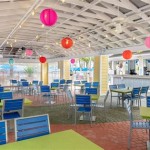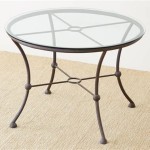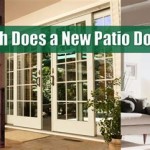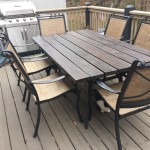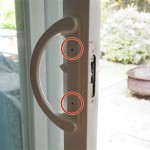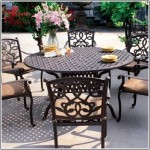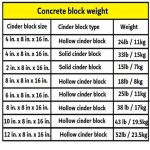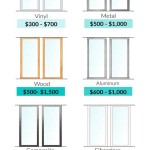Patio Dining Tables: A Comprehensive Guide to Outdoor Dining Furniture
Patio dining tables are essential components of outdoor living spaces, providing a dedicated area for meals, gatherings, and relaxation. Selecting the right patio dining table involves considering various factors, including size, shape, material, style, and budget. This article provides a comprehensive overview of patio dining tables, exploring the different aspects to consider when making a purchase decision.
Understanding Table Sizes and Shapes
The size and shape of a patio dining table are primary considerations, directly impacting the number of people it can accommodate and its overall footprint within the outdoor space. Correctly determining the appropriate size and shape can enhance the functionality and aesthetic appeal of the patio.
Size Considerations: The size of the patio area is crucial. A table that is too large will overwhelm a small patio, making it feel cramped. Conversely, a small table in a large patio may appear insignificant and not utilize the space effectively. It is advisable to measure the available space before considering any table, accounting for walkway space and seating arrangements. As a general guideline, allow at least 36 inches around the table for comfortable chair movement.
For smaller patios or balconies, bistro tables or tables seating two to four people are optimal. These are typically 30-48 inches in diameter or width. Mid-sized patios can accommodate tables seating four to six, usually ranging from 48-72 inches in diameter or length. Larger patios can handle tables seating six or more, which can be 72 inches or greater, potentially extending to 96 inches or more depending on the desired capacity.
Shape Considerations: Patio dining tables come in various shapes, each with its own advantages and disadvantages. The most common shapes are round, square, rectangular, and oval.
Round tables are excellent for promoting conversation, as everyone is seated at an equal distance from each other. They are well-suited for smaller spaces and can create a more intimate dining experience. Square tables are similar to round tables in that they provide equal access and proximity for diners. They are often used for seating four people.
Rectangular tables are the most common choice, particularly for larger groups. They maximize seating capacity and are well-suited for narrow patios or decks. Oval tables offer a similar seating capacity to rectangular tables but with softer edges, which can be more visually appealing and potentially safer in households with young children. Oval tables also take up slightly less physical space when compared to rectangular tables with similar capacity.
The choice of shape should also consider the overall style of the patio. Round and oval tables tend to lend themselves to more informal or traditional settings, while rectangular tables can work well in both formal and informal settings depending on the material and design.
Exploring Material Options for Patio Dining Tables
The material of a patio dining table significantly influences its durability, aesthetic appeal, and maintenance requirements. Common materials include wood, metal, plastic, and composite materials. Each material offers distinct advantages and disadvantages in terms of weather resistance, maintenance, cost, and style.
Wood: Wood is a classic and popular choice for patio dining tables, offering a natural and warm aesthetic. Teak, cedar, and eucalyptus are commonly used due to their inherent resistance to rot and insects. However, wood furniture generally requires regular maintenance, such as cleaning, sealing, or staining, to protect it from the elements and prevent fading, cracking, or warping.
Teak is particularly prized for its durability and natural oils, which provide excellent weather resistance. Over time, teak will develop a silver-gray patina if left untreated, which many find aesthetically pleasing. However, teak furniture can be more expensive than other wood options.
Metal: Metal tables are known for their strength, durability, and resistance to the elements. Aluminum, steel, and wrought iron are common choices. Aluminum is lightweight, rust-resistant, and relatively inexpensive, making it a popular option for casual outdoor dining. Steel is stronger than aluminum but can rust if not properly treated with a powder coating or other protective finish. Wrought iron is heavy, durable, and adds an elegant touch to a patio. However, it is susceptible to rust and requires regular maintenance to prevent corrosion.
Metal tables can also conduct heat, becoming hot to the touch in direct sunlight. Using cushions or umbrellas can help mitigate this issue. Powder-coated metal finishes offer increased protection against rust and corrosion, extending the lifespan of the furniture.
Plastic and Resin: Plastic and resin tables are lightweight, affordable, and resistant to water and stains. They are often made from recycled materials, making them an environmentally friendly option. However, plastic furniture can be less durable than wood or metal and may fade or crack over time, especially in harsh sunlight. Resin furniture, often made from polyethylene, is more durable and resistant to the elements than standard plastic. It can also be molded to resemble wood or wicker, offering a more sophisticated aesthetic.
Plastic and resin tables are easy to clean and require minimal maintenance, making them a practical choice for busy households or those prioritizing low maintenance.
Composite Materials: Composite materials, such as concrete or faux stone, offer a blend of durability and aesthetic appeal. Concrete tables are heavy and sturdy, providing a contemporary and industrial look. They are highly resistant to weather conditions but can be prone to staining and may require sealing. Faux stone tables are made from a blend of materials designed to mimic the look and feel of natural stone. They are lighter than concrete and more resistant to staining, making them a practical alternative.
Composite materials can be more expensive than other options but offer a unique and durable solution for outdoor dining.
Matching Style and Aesthetics to Your Outdoor Space
The style and aesthetics of a patio dining table should complement the overall design of the outdoor space. Considering the existing furniture, landscaping, and architectural style of the home is crucial for creating a cohesive and visually appealing patio area. Styles range from traditional and rustic to modern and contemporary, each with its own distinct characteristics.
Traditional Style: Traditional patio dining tables often feature ornate details, such as curved legs, intricate carvings, and classic finishes. Wood and wrought iron are common materials used in traditional designs. These tables tend to evoke a sense of elegance and formality, making them suitable for more formal outdoor settings.
Choosing traditional style tables may also align with more classical architectural styles of a home, thus strengthening the cohesive feel between indoor and outdoor spaces.
Rustic Style: Rustic patio dining tables emphasize natural materials, such as reclaimed wood, rough-hewn timber, and weathered finishes. They often have a simple and unrefined aesthetic, evoking a sense of warmth and authenticity. Rustic tables are well-suited for informal outdoor settings, such as country homes or cabins.
Modern Style: Modern patio dining tables are characterized by clean lines, minimalist designs, and neutral colors. Metal, glass, and concrete are commonly used in modern constructions. These tables tend to have a sleek and contemporary look, making them suitable for modern homes and urban spaces. Simple angles and use of singular materials make them stand out and blend well with minimalistic decors.
Contemporary Style: Contemporary patio dining tables blend elements of modern and traditional styles, offering a balance of sophistication and comfort. They may feature clean lines and minimalist designs but with softer edges and warmer materials. Contemporary tables are versatile and can complement a wide range of outdoor settings.
In addition to style, the color of the patio dining table should also complement the surrounding environment. Neutral colors, such as black, gray, and brown, are versatile and can blend seamlessly with various outdoor settings. Brighter colors can add a pop of visual interest but should be used sparingly to avoid overwhelming the space. Consider the color of the patio flooring, furniture cushions, and landscaping when selecting the color of the patio dining table.
Ultimately, the choice of style and aesthetics depends on personal preferences and the overall design goals for the outdoor space. By carefully considering the existing elements and selecting a table that complements the surrounding environment, it is possible to create a cohesive and visually appealing patio area that enhances the enjoyment of outdoor living.
Consider the table's ease of assembly and maintenance. Some tables require more assembly than others, and some materials require more frequent cleaning and upkeep. Reading reviews from other customers can provide valuable insights into the real-world experiences of owning a particular table.

Resin Wicker Dining Table Only 96 X 42 In Stock 5 Colors No Chairs Has Umbrella Hole

Aoodor Outdoor 6 10 Person Aluminum Extendable Dining Table For Patio Deck Garden Courtyard Charcoal Only 800 170 Bk The Home Depot

Aoodor Outdoor 6 10 Person Aluminum Extendable Dining Table For Patio Deck Garden Courtyard Charcoal Only 800 170 Bk The Home Depot

Resin Wicker Dining Table 72 Oval Only Has Umbrella Hole

Noble House Bennett Brown Rectangle Metal Outdoor Dining Table Only 7956 The Home Depot

Berlin Gardens 44 X 96 Classic Outdoor Dining Height Table From

Resin Wicker Dining Table Only 60 Round 5 Colors No Chairs Has Umbrella Hole

Crestlive S Gray Aluminum Outdoor Wood Like Dining Table Cl Tb012gry The Home Depot

Noble House Phoenix Patio Dining Table In Hammered Broe Only Nfm 2024

Berlin Gardens 44 Square Poly Patio Dining Table From Dutchcrafters
Related Posts

